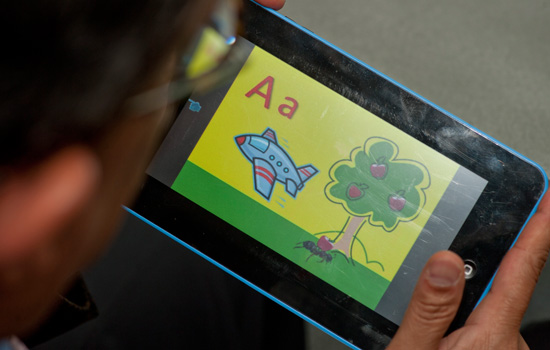
經過在印度偏遠鄉村近一年的使用測試後,研究者們已準備大量生產一種名為I-slate的超低功耗平板電腦,且其售價僅為35美元。
I-slate平板電腦設計用於教授那些學校用電緊張或根本無學可上的學生們學習數學和其他科目。該設備將於明年開始全面生產,並首次應用了一種名為隨機互補性金屬氧化物半導體(probabilistic CMOS)低功耗技術,可延長電池的使用時間。
隨機互補性金屬氧化物半導體法非常簡單:運行一個普通的微芯片,犧牲一小部分的精確性,得到高能效回報。這種方法在處理圖形和聲音方面非常出色,原因是人的視覺和聽覺並不那麼完美無瑕,些許小的錯誤是我們察覺不到的。(CMOS是現今大多數芯片所應用的技術。)
2006年,美國萊斯大學教授、新加坡南洋理工大學的可持續納米電子學研究所的負責人克里希納·帕萊姆(Krishna Palem)第一次向外界展示了隨機互補性金屬氧化物半導體。而目前,帕萊姆正忙於將此技術進行多種應用,包括一種低能耗的助聽器。他表示,教學性平板設備中的隨機芯片將大大地節約能源:這種平板設備只需要3瓦特的電量,也就是說那些安裝在袖珍計算器中的太陽能電池就能啟動它。
I-slate看上去像一台iPad平板電腦,擁有一個7英寸液晶觸摸屏。但它不是一個真正的平板電腦——實際上,和那些資助落後地區兒童的項目如“每人一機”等為孩子們提供的硬件設備所不同的是,它根本就不是一台電腦,也沒有所謂的操作系統。“它是一台精巧的、單一功能的設備,” 帕萊姆說。孩子們可以通過觸筆在屏幕上操作來閱讀預載的教科書或做筆記或算數學題。設備還能夠存儲幾頁筆記。
帕萊姆在南陽理工學院的團隊正在與印度一家非營利性組織村莊學習和發展基金會(Villages for Development and Learning Foundation)以及洛杉磯的Seso設計公司合作,共同開發I-slate設備。去年,其團隊在印度海得拉巴市西南70英里處的一座小村莊Mohd Hussainpalli的學校裡測試了I-slates原型,該原型設備加載了這所學校的數學教科書和習題。在印度的這片地區,供電並不穩定,一些村子裡也沒有教師。
Seso公司總裁馬克·梅爾滕斯(Marc Mertens)設計了I-slate設備的界面。他說,這個挑戰在於要解決“在確保I-slate所要做的越少越好的前提下,哪種理想方式最適用於學生”這個問題。這種方法使得硬件成本和能量消耗處於最低值。動畫以及其他復雜的、有豐富媒體的工具根本是行不通的。那個數學項目是基於那一地區的教科書標準並允許學生按照自己的學習進度來進步。他們遇到不懂的東西可以選擇跳過。老師可以下載學生電腦中的信息來監督他們的學習進度。
該實地測試使用的是內置傳統芯片的原型設備。測試表明了學生的數學水平在使用I-slate過程中有所提高。明年,研究者們將開始生產這種耗電量為3瓦特、使用太陽能電池的平板設備。
“我們一直在減少硬件的構成,然後評估界面和課程的有效性,”帕萊姆說。“當我們認為用戶界面看上去很舒服時,就會將它轉用到隨機芯片上。”
在帕萊姆的團隊不斷地升級硬件時,梅爾滕斯正致力於擴展可以放在I-slate中的課程。設計一個給數學測試打分的項目要比設計寫作項目簡單得多。“我們正在探索如何使這個設備超越數學,支持更多的創新性課程,”他說。

I-Slate已經完成了第一階段的研發,現在正在印度的小學裡作測試
如果測試的結果成功,就會在螢幕的上方裝上太陽能板
類似下圖的計算機

鄉村學習發展基金會的董事長Rajeswari Pingali說:
印度鄉村裡的小學生就如同其他同年的孩子一樣
渴望學習新事物、追求高科技而且喜歡嘗試新的教具
I-Slate可以為這些鄉下的小學帶來很多好玩的事情,也可以改善學生的學習經驗

I-Slate which was said to be the low cost Tablet is entering in to the second phase. After numerous experiments performed by group of schools on this educational device, the I-Slate is stepping into the production stage.
This product was initially announced last year which was developed by Institute for Sustainable and Applied Infodynamics (ISAID), a joint venture of Houston’s Rice University and Singapore’s Nanyang Technological University. This is said to be the Tablet which will be sold for less than US $50.
Though the future versions of this Tablet are expected to run using solar power, the initial version will have the traditional battery in it. Project leader Krishna Palem has created an extremely low power chip which gets the power from the in-built solar cells. These cells are similar to what is being used in calculators. The main reason behind such an innovation is to use the Tablets in areas where there are frequent electrical outages.
As it is mainly for educational purpose, the Tablet will come with educational software utilizing extreme low power. Installation of other software may not be possible. The trial version which was tested out in 2010 had the mathematics programs installed in it. This program helped the students to know the reason for wrong answers.
With the feedback from students, the upcoming versions will have the science and social lessons included along with the mathematics programs. Also there are plans for the integration of social networking apps in the Tablet.
Soon, 50 I-Slates powered by battery will be reaching India to get tested. By mid of 2012, solar cell based Tablets are expected to reach the audience. As of now there are no words of its release to other countries.
來源:http://www.tabletpcexpert.co.uk/news/i-slate-low-cost-educational-tablet-kids/



 留言列表
留言列表